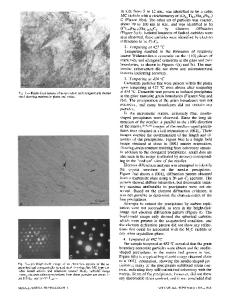SCC path in forged aermet 100 steel
- PDF / 1,173,190 Bytes
- 4 Pages / 613 x 788.28 pts Page_size
- 83 Downloads / 320 Views
Authors' Reply W.S. SPEAR and D.H. POLONIS The authors thank Dr. Golovin for his discussion of our article and for providing some interesting ideas evolving from his work on Fe-Cr alloys. In our work, the activation energy of 90 kJ/mole associated with the first stage reaction, i.e., the precipitation of carbonitrides, was determined only for the Fe-18 pct Cr-AI alloys. The apparent agreement with the activation energy for the interstitial diffusion of C and N in alpha iron was used to support our arguments that the diffusion of these interstitial elements control the first stage of the reaction. It is clear, based on Dr. Golovin's data, that the activation energy for the interstitial diffusion of C and N in Fe-17 pct Cr-2 pct Mo is significantly higher than that in alpha iron. However, the effects are unlikely to be the same for the ternary alloys containing A1 atoms, which introduce significant elastic strain in the bcc Fe lattice due to their relatively greater atomic size. Accordingly, the lattice distortion can be expected to enhance the diffusion of interstitial atoms and also lower the activation energy. Dr. Golovin suggests that three stages of decomposition occur during the aging of Fe-Cr alloys, namely, carbonitrides, followed by the formation of interstitialsubstitutional complexes and subsequently alpha-prime precipitation. Our investigation revealed two distinct microstructural stages of decomposition involving precipitate formation. The experimental methods employed in our work are not sufficiently sensitive to distinguish unambiguously between concurrent carbonitride precipitation and the formation of interstitial-substitutional complexes as a precursor to alpha-prime nucleation. However, the resistometric measurements did suggest that clustering of Cr atoms occurs prior to the onset of the second stage reaction, ul Such clustering could correspond to the formation of interstitial-substitutional complexes, as suggested by Dr. Golovin. It is our view that his work substantiates this notion and is additionally valuable in explaining why higher levels of C and N are associated with the enhanced alpha-prime precipitation and embrittlement observed in our investigation.
REFERENCES 1. W.S. Spear: Ph.D. Seattle, WA, 1987.
Dissertation, University of Washington,
E.U. LEE AerMet 100, a Co-Ni alloy steel, was recently developed by Carpenter Technology Corporation (Reading, PA). This steel, strengthened by C, Cr, and Mo, has an outstanding combination of high fracture toughness, a K~c, exceeding 121 MPa m 1/2, and high tensile strength, 1931 to 2069 MPa. The steel has great potential for applications involving fracture critical components such as aircraft landing gears. The stress-corrosion cracking (SCC) behavior of this material was not fully understood, and a study 1~'2~was undertaken to characterize this property. In the course of this investigation, the observation was made that the path of the stress-corrosion crack was associated not only with the grain boundary but also with the prior deformation inc
Data Loading...











